In Africa, there are two deadly vipers almost unheard of in the western world. These snakes are among the heaviest venomous snakes in the world, and, they’re rarely seen. When it comes to the Gaboon viper vs rhino viper, there are a few key differences. Here, we’ll learn more about these two incredible snakes, where they live, how they hunt, what they eat, and what they look like.
Read on to learn the exact differences between the Gaboon viper vs rhino viper!
Comparing Gaboon Viper vs Rhino Viper
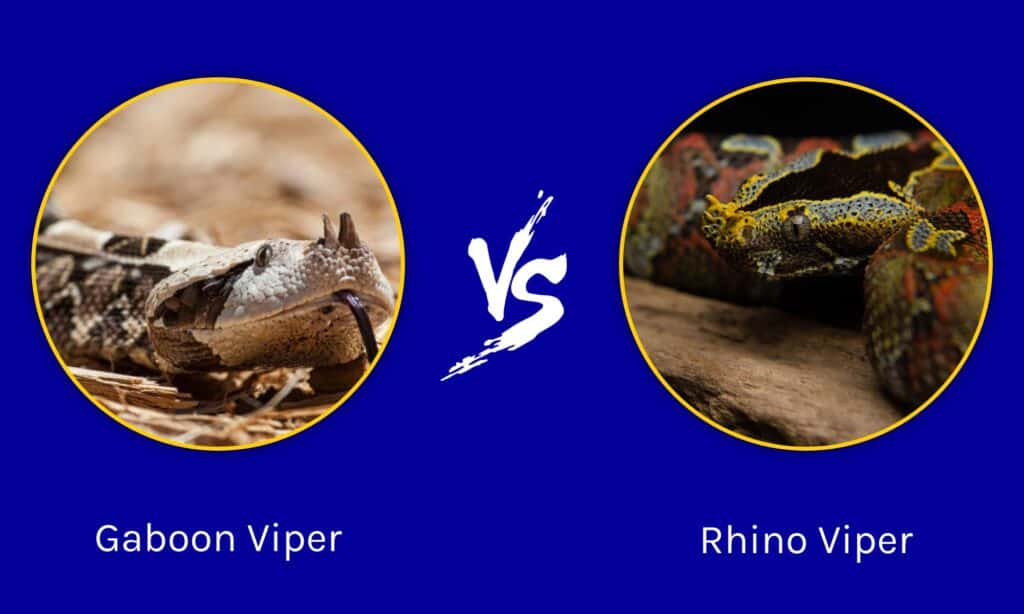
| Gaboon Viper | Rhino Viper | |
|---|---|---|
| Size | 4-7 feet | 2.5-4 feet |
| Appearance | Brown, tan, and black patterns with a heavy body and leaf-shaped head | Patterns of red, yellow, black, and blue; hornlike scales on the nose |
| Location and Habitat | Central Africa; forest floors | Central and West Africa; forests and swamps |
| Behavior | Nonaggressive, slow-moving, nocturnal | Nonaggressive, slow-moving, nocturnal |
| Lifespan | 15-20 years | 8-12 years |
Key Differences Between Gaboon Viper vs Rhino Viper
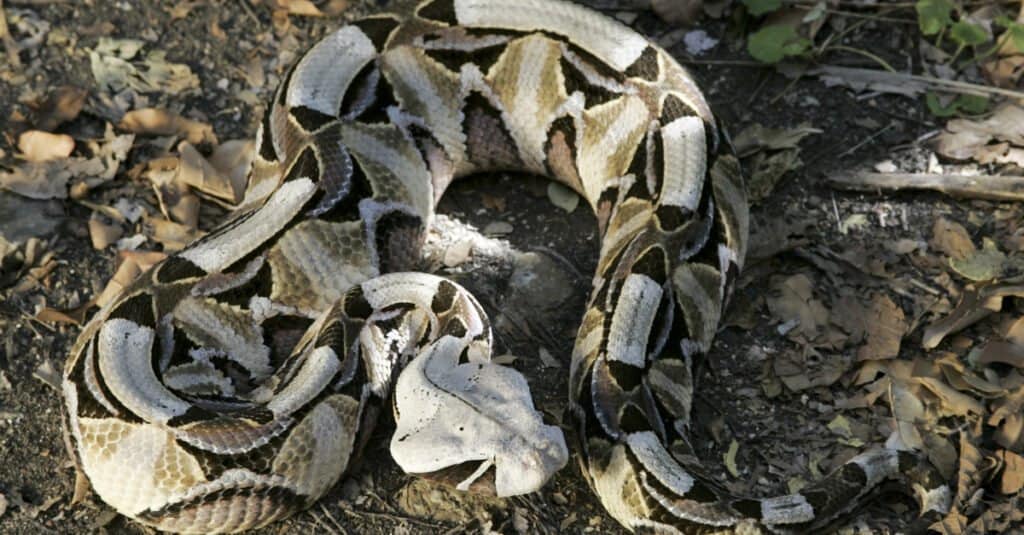
Gaboon vipers grow up to seven feet long, while rhino vipers top out around four feet.
©Stu Porter/Shutterstock.com
The key difference between the Gaboon viper and the rhino viper is that Gaboon vipers are significantly larger and heavier than rhino vipers. Rhino vipers may be pint-sized in comparison, but their venom still packs a punch. Gaboon vipers lack the brilliant blue, red, and green shades of the rhino viper. Also, rhino vipers have distinctive ‘horn’ scales on their snouts that Gaboon vipers lack. And, since they’re smaller, rhino vipers have smaller fangs than the Gaboon viper. But, then again, the Gaboon viper’s fangs dwarf those of just about every other snake.
Let’s take a closer look at the exact differences between Gaboon viper and rhino viper.
Gaboon Viper vs Rhino Viper: Size and Weight
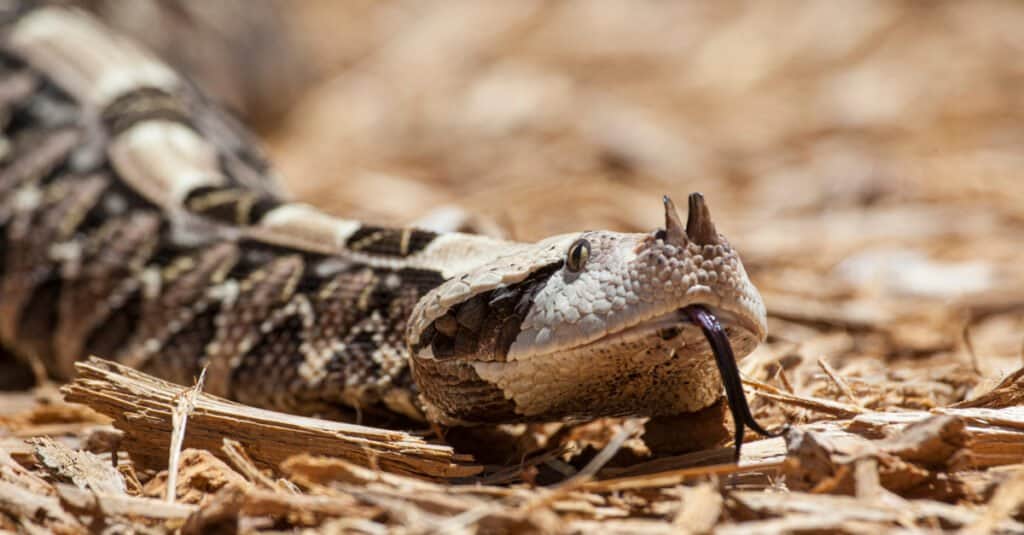
The Gaboon viper is one of the heaviest snakes on Earth, especially considering its relatively short length.
©Danita Delimont/Shutterstock.com
To start, Gaboon vipers are much larger than rhino vipers. Luckily for the smaller snake, the Gaboon viper does not generally hunt reptiles. Gaboon vipers can grow up to seven feet long, though most are recorded around 5-6 feet. Rhino vipers grow to an average length of 3-3.5 feet, though some may grow to just over four feet.
There is also a difference in the weight of each species. Gaboon vipers are some of the heaviest snakes in the world, inch per inch, they’re extremely weighty. With their thick bodies, these snakes can exceed 25 pounds. Rhino vipers are shorter, and while heavy-bodied, they’re not nearly as thick as the Gaboon viper. The rhino viper grows to around 10 pounds max.
Gaboon Viper vs Rhino Viper: Location and Habitat
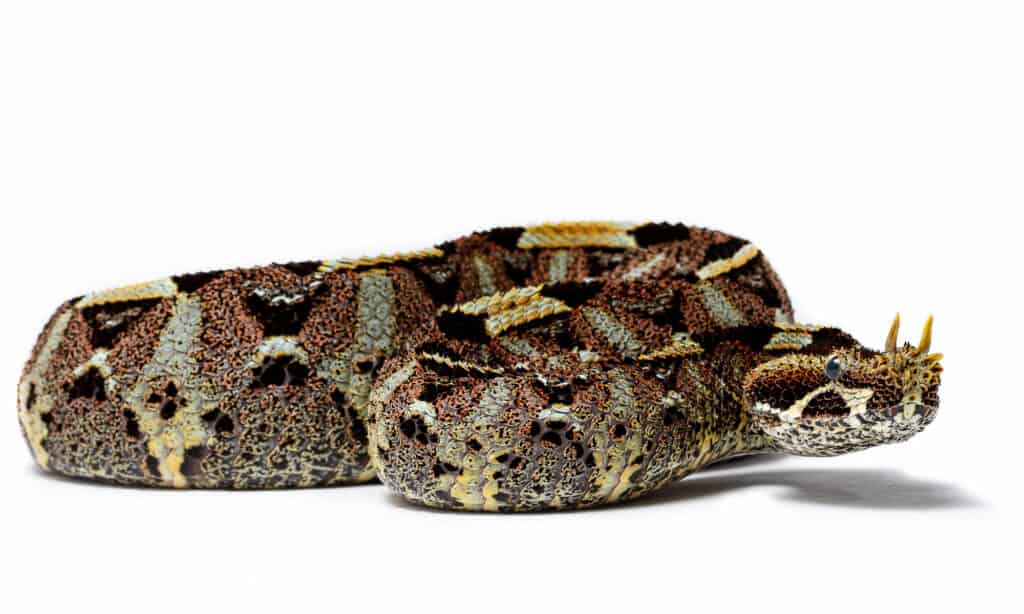
While the Gaboon viper and rhino viper share some of their range, they also have distinct ranges in west and southern Africa.
©Scott Delony/Shutterstock.com
Both the Gaboon viper and the rhino viper live in the tropical rainforests of Central Africa. Rhino vipers also live in the coastal regions of extreme west Africa. Gaboon vipers live in a few of the rainforests of east and southern Africa.
Gaboon vipers live exclusively on the forest floor of thick, humid rainforests. Rhino vipers are a little more diverse in their habitat preference and can be found in swamps as well as rainforests. While the Gaboon viper is strictly terrestrial, the rhino viper may climb into trees in search of prey.
Gaboon Viper vs Rhino Viper: Appearance
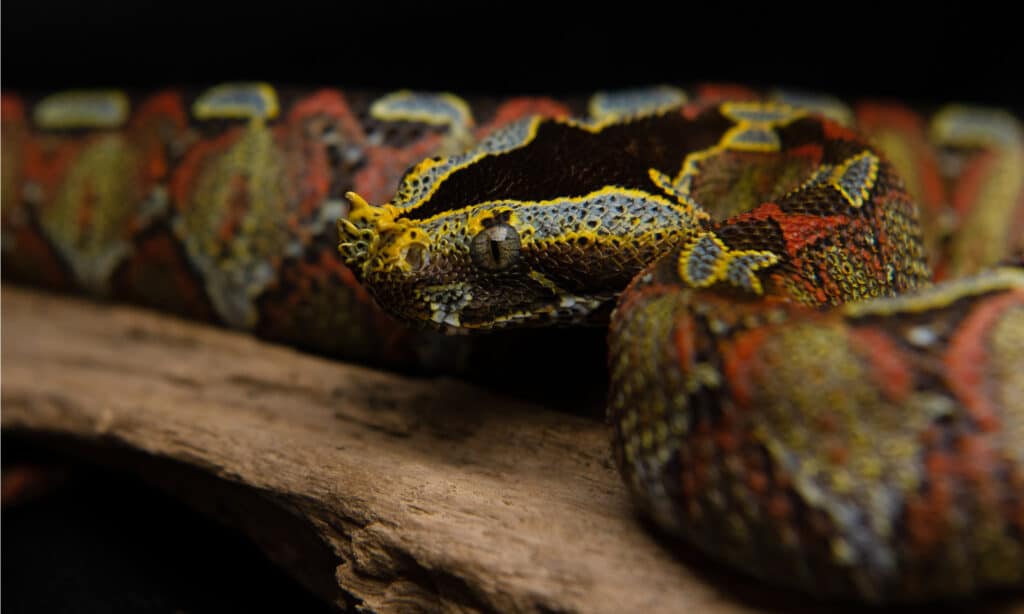
Rhino vipers have distinct, black, arrow-shaped markings on the backs of their heads.
©Olivia Lundborg/Shutterstock.com
When it comes to appearance, the Gaboon viper and the rhino viper are similar in many ways. Gaboon vipers have heavy bodies and extremely broad, leaf-shaped heads. Their eyes are yellow, with black, vertically elliptical pupils. Rhino vipers have shorter, but still heavy, bodies. Their heads are leaf-shaped, though not as robust as the Gaboon viper. Rhino vipers also have a series of sharp, erect scales on their nose that resemble a horn.
Both snakes have extraordinary patterning and coloring. The Gaboon vipers’ colors include every shade of brown and tan, as well as black. Rhino vipers have red, blue, yellow, black, brown, and gray scales. Both snakes have patterns made of all kinds of geometric shapes that come together to create an incredible form of camouflage.
Gaboon Viper vs Rhino Viper: Behavior
Gaboon viper and rhino viper share the same favorite prey: rodents, like mice and rats. Both species wait in ambush for prey to stray close, then, with one of the fastest strikes of any snake, they grab their dinner. Both the Gaboon viper and the rhino viper are nocturnal. They spend their days hidden in leaf litter, and their nights waiting, motionless, for a meal to cross their path.
While the Gaboon viper and rhino viper are incredibly venomous, bites on humans are exceedingly rare. Both snakes are shy and unaggressive; almost all bites happen in cases of harassment or accidental stepping on. While these snakes are known to be unaggressive, they’re unfortunately frequently killed by fearful humans.
Gaboon Viper vs Rhino Viper: Reproduction & Lifespan
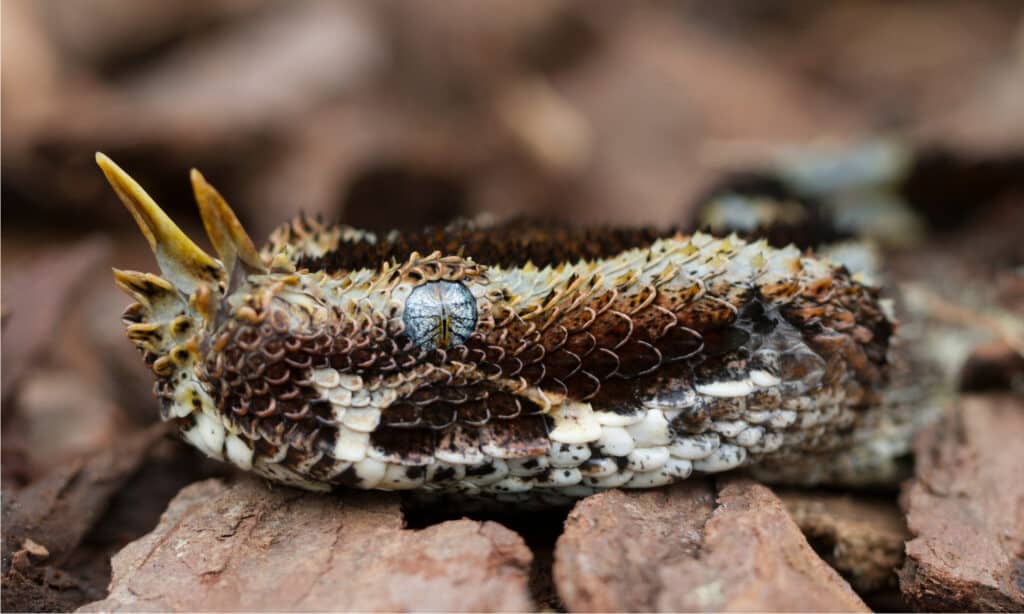
Though data is scarce, it’s thought that Gaboon vipers live a little longer than rhino vipers.
©Mark_Kostich/Shutterstock.com
When it comes to the lifespan of Gaboon vipers and rhino vipers, the difference is slight. Gaboon vipers are bigger and can live up to 20 years in the wild. With their smaller size, rhino vipers don’t live quite as long, with most estimates putting their lifespan between 8-15 years.
When it comes to reproduction, both species give birth to live young. They don’t lay eggs. Instead, the eggs actually fully develop, then hatch, inside the mother. Gaboon vipers can have up to 60 babies per birth, while rhino vipers can have between 1-20. For both species, mortality rates for the young are high.
The photo featured at the top of this post is © Olivia Lundborg/Shutterstock.com
Discover the "Monster" Snake 5X Bigger than an Anaconda
Every day A-Z Animals sends out some of the most incredible facts in the world from our free newsletter. Want to discover the 10 most beautiful snakes in the world, a "snake island" where you're never more than 3 feet from danger, or a "monster" snake 5X larger than an anaconda? Then sign up right now and you'll start receiving our daily newsletter absolutely free.
Thank you for reading! Have some feedback for us? Contact the AZ Animals editorial team.






